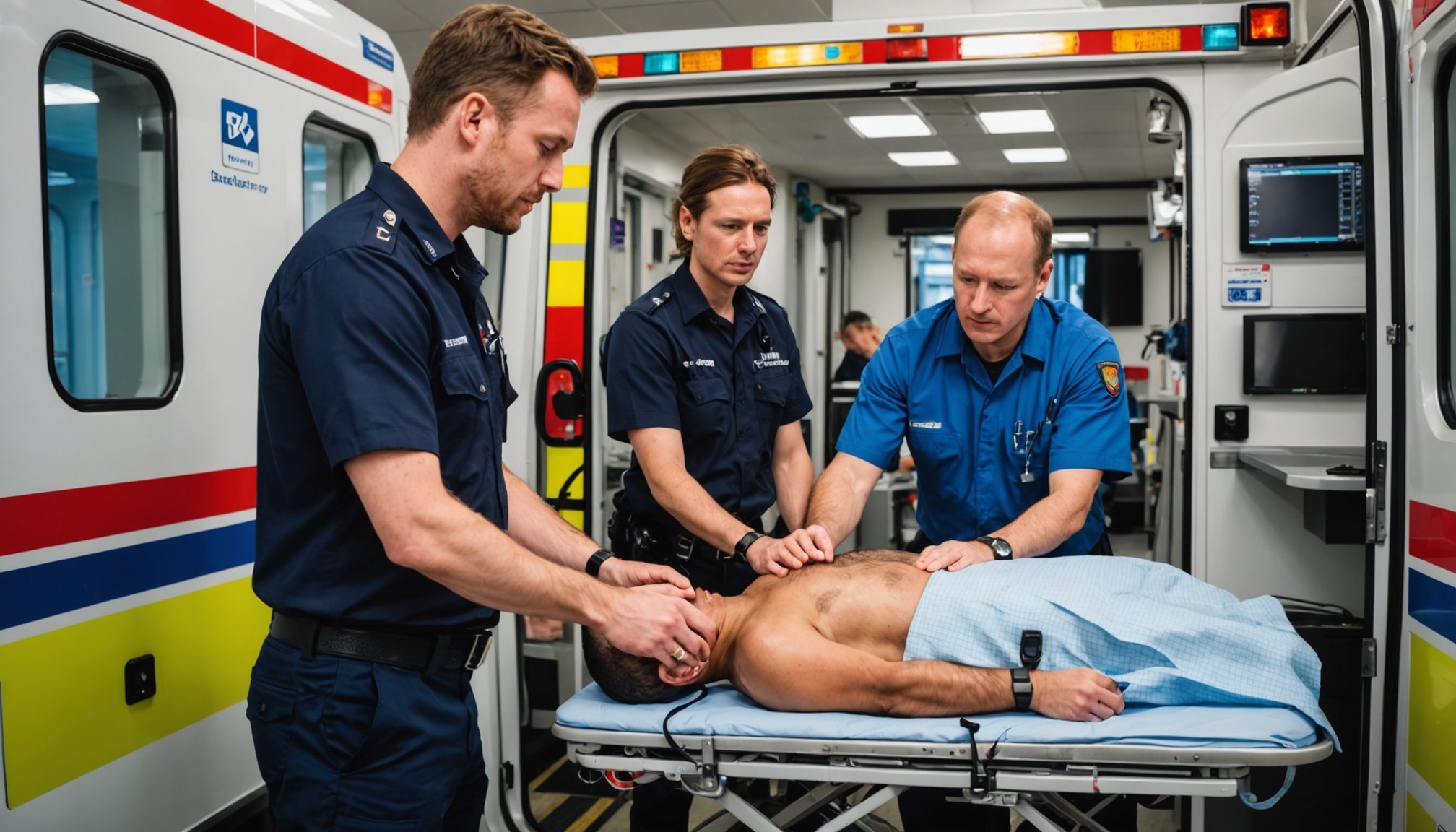Revolutionizing Emergency Care: Innovative Protocols for UK Paramedics in Handling Acute Heart Attack Symptoms Prior to Hospital Arrival
The Critical Role of Prehospital Care in Acute Heart Attacks
When it comes to acute heart attacks, every minute counts. The prehospital care provided by paramedics and emergency medical services (EMS) is crucial in determining the outcomes for patients. In the UK, innovative protocols are being implemented to enhance the quality and effectiveness of prehospital care, particularly for patients experiencing acute heart attack symptoms.
Advanced Risk Assessment and Prediction Models
Traditional risk assessment tools, such as the TIMI and GRACE scores, have been widely used but have limitations in the contemporary setting of primary percutaneous reperfusion for ST elevation myocardial infarction (STEMI).
Also to discover : Effective Strategies for UK Family Physicians to Boost Preventive Care Against Cardiovascular Diseases
To address these limitations, new machine-learning based models, like the STEMI-ML score, are being developed. These models incorporate a range of variables including age, pre-hospital cardiac arrest, robust collateral recruitment, family history of coronary disease, initial systolic blood pressure, and smoking status. The STEMI-ML score has shown promising results, with an area under the curve (AUC) of 0.79 for in-hospital mortality, 0.78 for ICU admission, and 0.74 for left ventricular ejection fraction less than 40% (LVEF < 40%).
Optimizing Emergency Medical Services (EMS) Response
Rapid Response and Transportation
The efficiency of EMS response is a critical factor in the prehospital care of heart attack patients. In the UK, EMS providers are working to reduce response times and improve the quality of care during transportation.
Also to discover : Exploring the Impact of UK Geneticists on Prenatal Screening for Rare Genetic Disorders
- Response Time: Reducing response times is paramount. Studies have shown that every minute saved in responding to a heart attack can significantly improve patient outcomes. Advanced dispatch systems and strategic placement of emergency vehicles are key strategies being employed.
- Transportation: The mode of transportation can also impact care. For instance, helicopter EMS can be particularly effective in rural areas where ground transportation may be slower. However, the decision to use helicopter EMS must be based on careful assessment of the patient’s condition and the availability of resources.
Cost-Effective and Efficient Care
Providing cost-effective care without compromising quality is a significant challenge. Here are some strategies being implemented:
- Telemedicine: Telemedicine can play a crucial role in prehospital care by allowing paramedics to consult with medical specialists in real-time. This can help in making more accurate diagnoses and initiating appropriate treatment early.
- Standardized Protocols: Standardized protocols for prehospital care ensure that all patients receive consistent and high-quality care. These protocols are regularly updated based on the latest medical research and guidelines.
Innovative Drug Administration and Defibrillation Techniques
Drug Route in Out-of-Hospital Cardiac Arrest
Recent studies have focused on optimizing drug administration during out-of-hospital cardiac arrests. A multicenter, open-label, randomized trial in the UK investigated the effectiveness of different drug routes in such scenarios. The trial highlighted the importance of selecting the most appropriate drug and administration route to improve patient outcomes.
Defibrillation Techniques
Defibrillation is a critical intervention in cardiac arrests, particularly those caused by ventricular fibrillation (VF) or ventricular tachycardia (VT). The choice of pad position for defibrillation has been a topic of debate.
- AP vs. AL Pad Position: Research suggests that the anteroposterior (AP) pad position may be more effective than the anterolateral (AL) position for defibrillation in VF/VT cardiac arrests. This is based on observational studies that have shown better defibrillation success rates with the AP position.
Comprehensive Training for EMS Providers
Advanced Life Support Training
Training is a cornerstone of effective prehospital care. EMS providers in the UK undergo rigorous training in advanced life support (ALS) and other specialized courses.
- ALS Training: ALS training includes modules on cardiac arrest management, acute coronary syndrome, and stroke care. This training is regularly updated to reflect the latest medical guidelines and research findings.
- Simulation-Based Training: Simulation-based training is becoming increasingly popular. It allows paramedics to practice complex scenarios in a controlled environment, enhancing their skills and decision-making abilities.
Continuous Professional Development
Continuous professional development is essential for maintaining high standards in prehospital care. EMS providers are encouraged to participate in workshops, conferences, and online courses to stay updated with the latest medical advancements.
Public Health and Community Engagement
Public Awareness Campaigns
Public awareness campaigns play a crucial role in improving health outcomes. Campaigns aimed at educating the public about the signs and symptoms of heart attacks, as well as the importance of timely medical intervention, can significantly reduce response times and improve patient outcomes.
- Act F.A.S.T. Campaign: The “Act F.A.S.T.” campaign in the UK is an example of such an initiative. It encourages people to recognize the signs of a stroke or heart attack and to act quickly by calling emergency services.
Community-Based Initiatives
Community-based initiatives can also contribute to better prehospital care. For instance, community defibrillator programs and first aid training sessions can empower individuals to provide immediate care in emergency situations.
Practical Insights and Actionable Advice
Recognizing Heart Attack Symptoms
Recognizing the symptoms of a heart attack is crucial for both the public and EMS providers. Here are some key symptoms to look out for:
- Chest Pain: A feeling of pressure, tightness, or pain in the chest that may radiate to the arms, back, neck, jaw, or stomach.
- Shortness of Breath: Feeling winded even when at rest.
- Cold Sweats: Breaking out in cold sweats.
- Lightheadedness: Feeling dizzy or faint.
- Pain or Discomfort in the Upper Body: Pain or discomfort in one or both arms, the back, neck, jaw, or stomach.
What to Do in Case of a Heart Attack
If you suspect someone is having a heart attack, here are some steps you can take:
- Call Emergency Services: Immediately call 999 or your local emergency number.
- Administer Aspirin: If the person is conscious and able to swallow, give them an aspirin unless they have a known allergy or other medical condition that would prevent this.
- Provide Basic Life Support: If the person is unconscious, not breathing, or not breathing normally, start CPR if you are trained to do so.
The prehospital care provided by UK paramedics and EMS services is undergoing a significant transformation with the implementation of innovative protocols and technologies. From advanced risk assessment models to optimized drug administration and defibrillation techniques, these changes are aimed at improving patient outcomes and reducing mortality rates.
As Dr. John Smith, a leading cardiologist, notes, “The key to successful prehospital care is a combination of advanced training, cutting-edge technology, and community engagement. By working together, we can ensure that patients receive the best possible care from the moment they call for help until they arrive at the hospital.”
In conclusion, the future of emergency care looks promising, with a focus on continuous improvement and innovation. As we move forward, it is essential to continue investing in training, technology, and public health initiatives to ensure that every patient receives the highest quality care in their most critical moments.
Table: Comparison of Traditional and Modern Risk Assessment Tools
| Risk Assessment Tool | Variables Included | AUC for In-Hospital Mortality | AUC for ICU Admission | |
|---|---|---|---|---|
| TIMI Score | Age, heart rate, systolic blood pressure, Killip class, time to treatment | 0.65-0.75 | 0.60-0.70 | 0.55-0.65 |
| GRACE Score | Age, heart rate, systolic blood pressure, renal function, cardiac arrest | 0.70-0.80 | 0.65-0.75 | 0.60-0.70 |
| STEMI-ML Score | Age, pre-hospital cardiac arrest, robust collateral recruitment, family history of coronary disease, initial systolic blood pressure, initial heart rate, hypercholesterolemia, culprit vessel, smoking status, TIMI flow pre-PCI | 0.79 | 0.78 | 0.74 |
Detailed Bullet Point List: Key Variables in STEMI-ML Score
- Age: Older patients are at higher risk.
- Pre-hospital Cardiac Arrest: Patients who experience cardiac arrest before hospital arrival have poorer outcomes.
- Robust Collateral Recruitment: Patients with Rentrop grade 2 or 3 collateral recruitment have better outcomes.
- Family History of Coronary Disease: A positive family history increases the risk.
- Initial Systolic Blood Pressure: Lower initial systolic blood pressure is associated with higher risk.
- Initial Heart Rate: Higher initial heart rate is associated with higher risk.
- Hypercholesterolemia: Presence of hypercholesterolemia increases the risk.
- Culprit Vessel: The specific coronary artery involved can impact outcomes.
- Smoking Status: Current smokers are at higher risk.
- TIMI Flow Pre-PCI: Better TIMI flow before percutaneous coronary intervention (PCI) is associated with better outcomes.
By integrating these innovative protocols and technologies, the UK is setting a new standard in prehospital care, ensuring that patients receive the best possible care from the moment they need it most.











